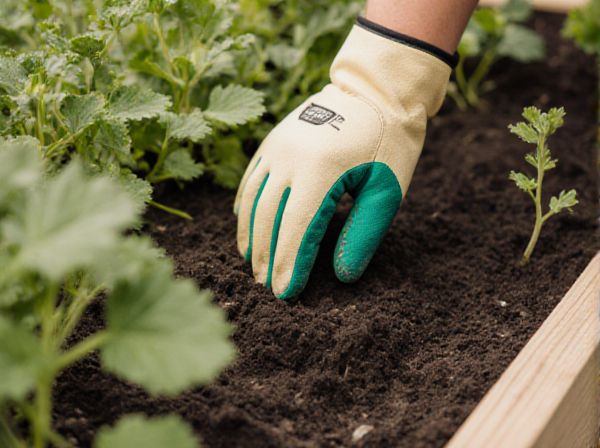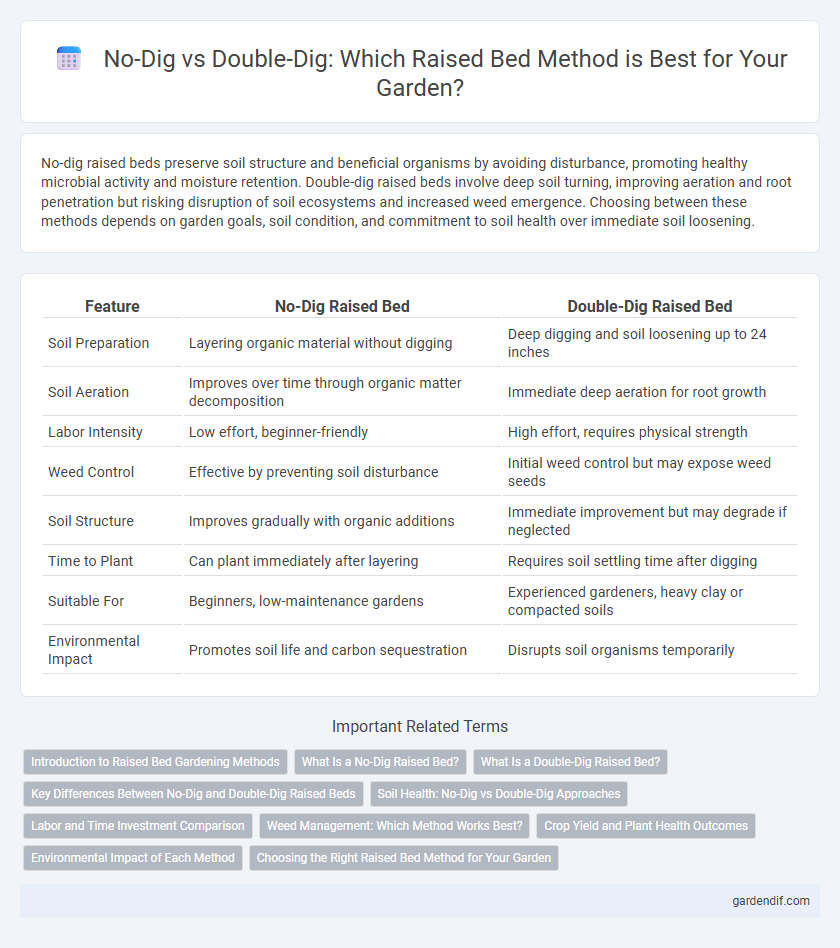
No-dig raised bed vs Double-dig raised bed Illustration
No-dig raised beds preserve soil structure and beneficial organisms by avoiding disturbance, promoting healthy microbial activity and moisture retention. Double-dig raised beds involve deep soil turning, improving aeration and root penetration but risking disruption of soil ecosystems and increased weed emergence. Choosing between these methods depends on garden goals, soil condition, and commitment to soil health over immediate soil loosening.
Table of Comparison
| Feature | No-Dig Raised Bed | Double-Dig Raised Bed |
|---|---|---|
| Soil Preparation | Layering organic material without digging | Deep digging and soil loosening up to 24 inches |
| Soil Aeration | Improves over time through organic matter decomposition | Immediate deep aeration for root growth |
| Labor Intensity | Low effort, beginner-friendly | High effort, requires physical strength |
| Weed Control | Effective by preventing soil disturbance | Initial weed control but may expose weed seeds |
| Soil Structure | Improves gradually with organic additions | Immediate improvement but may degrade if neglected |
| Time to Plant | Can plant immediately after layering | Requires soil settling time after digging |
| Suitable For | Beginners, low-maintenance gardens | Experienced gardeners, heavy clay or compacted soils |
| Environmental Impact | Promotes soil life and carbon sequestration | Disrupts soil organisms temporarily |
Introduction to Raised Bed Gardening Methods
No-dig raised beds minimize soil disturbance by layering organic mulch directly on top, preserving soil structure and beneficial microbes, which enhances long-term soil health and reduces weed growth. Double-dig raised beds involve manually loosening two layers of soil to improve aeration, root penetration, and drainage, but require significant labor and can disrupt soil ecosystems. Both methods boost plant productivity, yet no-dig techniques offer sustainable soil management with less physical effort compared to the intensive preparation of double-digging.
What Is a No-Dig Raised Bed?
A no-dig raised bed is a gardening method that avoids disturbing soil structure by layering organic materials such as compost, mulch, and cardboard directly on top of the existing soil. This technique enhances soil fertility, retains moisture, and suppresses weeds while preserving beneficial microorganisms and earthworms essential for soil health. Unlike double-dig raised beds, which require intensive soil turning and aeration, no-dig beds promote natural soil ecosystems with minimal labor.
What Is a Double-Dig Raised Bed?
A double-dig raised bed involves removing the topsoil and loosening the subsoil beneath to a depth of about two spades, typically 18 to 24 inches, which improves soil aeration and drainage. This method contrasts with no-dig beds by actively turning and enriching the soil, promoting deeper root growth and enhanced microbial activity. Double-digging requires more labor but can significantly increase soil fertility and crop yield over time.
Key Differences Between No-Dig and Double-Dig Raised Beds
No-dig raised beds rely on layering organic materials directly on top of the soil, preserving soil structure and microbial life, while double-dig raised beds involve manually turning and loosening soil to improve aeration and root penetration. No-dig methods save labor and maintain soil ecology, whereas double-digging enhances soil drainage and nutrient mixing but can disrupt soil organisms. The choice between no-dig and double-dig raised beds depends on soil condition, gardener preference, and desired effort level.
Soil Health: No-Dig vs Double-Dig Approaches
No-dig raised beds preserve soil structure and microbial life by minimizing disturbance, promoting long-term soil health and organic matter accumulation. Double-dig raised beds involve flipping and aerating soil layers, which initially boosts aeration and root penetration but can disrupt soil organisms and accelerate organic matter decomposition. Maintaining intact soil ecosystems in no-dig beds supports beneficial fungi and bacteria, crucial for nutrient cycling and sustainable plant growth.
Labor and Time Investment Comparison
No-dig raised beds significantly reduce labor and time investment by eliminating the need for soil turning and deep digging, making them ideal for gardeners seeking efficiency. Double-dig raised beds require intensive physical effort and several hours to loosen and aerate soil layers, which can be taxing but improves soil structure for long-term growth. Choosing between the two methods depends on available time, physical ability, and specific garden goals related to soil health and productivity.
Weed Management: Which Method Works Best?
No-dig raised beds minimize soil disturbance, reducing weed seed exposure and promoting a stable, weed-resistant soil ecosystem. Double-dig raised beds aerate and loosen soil deeply but can bring dormant weed seeds to the surface, potentially increasing weed growth. For effective weed management, no-dig raised beds are generally preferred due to their ability to suppress weeds naturally through undisturbed soil layers and organic mulch.
Crop Yield and Plant Health Outcomes
No-dig raised beds promote higher crop yields by preserving soil structure and beneficial microorganisms, reducing disturbance, and enhancing moisture retention. Double-dig raised beds improve aeration and root penetration but can disrupt soil ecosystems, potentially leading to slower soil regeneration and mixed plant health outcomes. Studies show no-dig methods sustain long-term soil fertility and healthier plants, resulting in more consistent and robust crop production compared to double-dig practices.
Environmental Impact of Each Method
No-dig raised beds preserve soil structure and microbial life by minimizing disturbance, promoting carbon sequestration and reducing erosion compared to double-dig beds. Double-dig raised beds involve significant soil turning, which can disrupt soil ecosystems and increase carbon release into the atmosphere. Choosing no-dig methods supports sustainable gardening practices by enhancing soil health and reducing environmental impact.
Choosing the Right Raised Bed Method for Your Garden
No-dig raised beds preserve soil structure and microbial life by layering organic matter on top without turning the soil, making them ideal for gardeners seeking low maintenance and improved soil health. Double-dig raised beds involve loosening the soil to a depth of 24 inches, enhancing root penetration and aeration, which benefits heavy clay or compacted soils that require deep cultivation. Selecting between no-dig and double-dig methods depends on existing soil conditions, garden goals, and the time available for soil preparation, ensuring optimal plant growth and sustainability.
No-dig raised bed vs Double-dig raised bed Infographic

 gardendif.com
gardendif.com